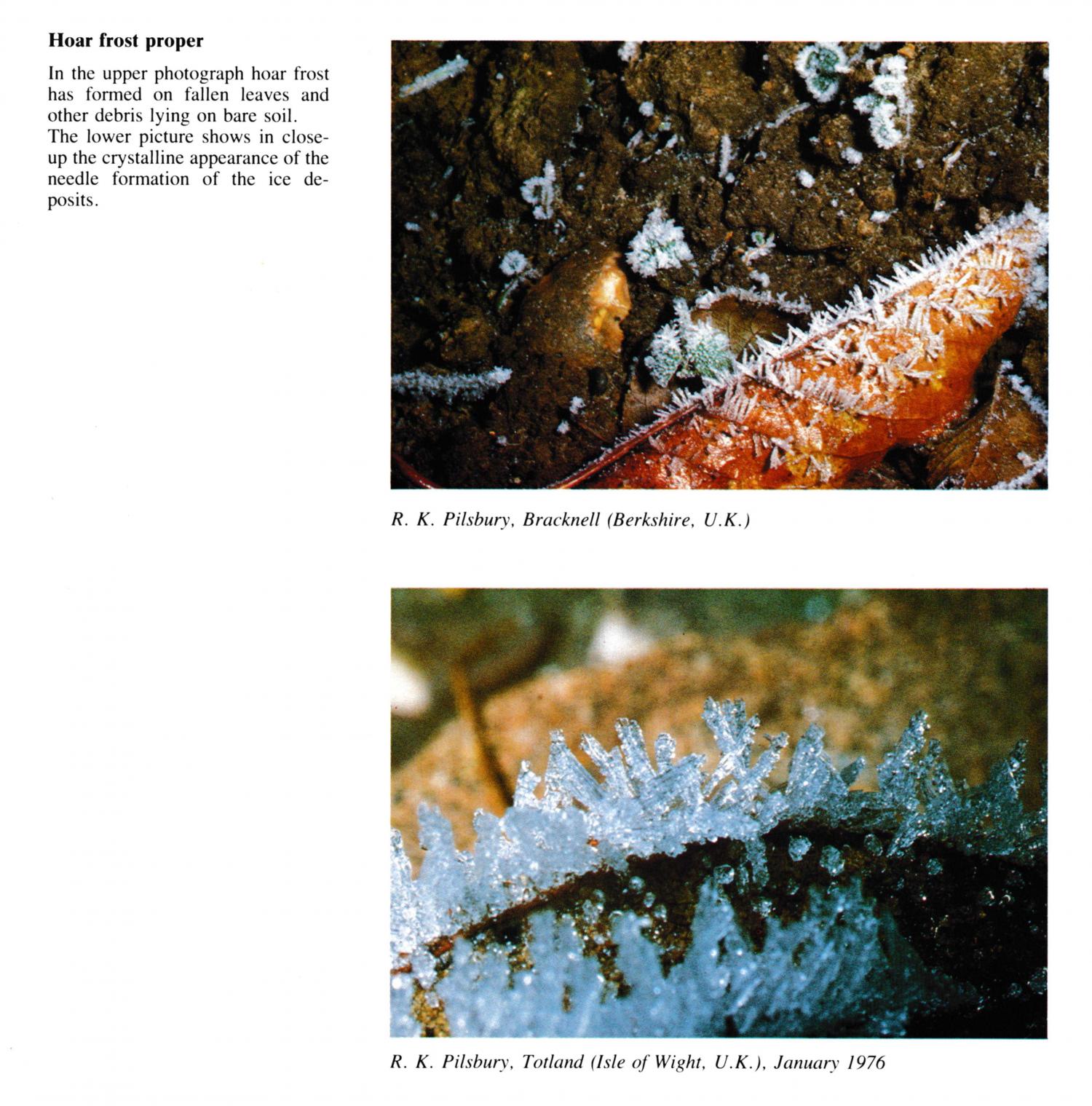© George Anderson
Wokingham, United Kingdom of Great Britain and Northern Ireland
Latitude: 51° 24' 50'' N
Longitude: 0° 51' 9'' W
13 December 2012 1052 (Local Time)
Image P/S code: P.11.4.4
Image I.D.: 4858
-

Hoar frost proper
Hoar frost is a deposit of ice crystals produced by the deposition of water vapour from the surrounding air. “Hoar frost proper” forms mainly on the horizontal surfaces of objects at or near the ground that are sufficiently cooled by nocturnal radiation, typically in conditions of clear sky and light wind.
This picture shows hoar frost deposited on blades of grass and fallen leaves on the ground. The photograph was taken after a cold night in which the air temperature fell to –5 °C. The temperature at the grass surface during the night ranged between –6 °C and –10 °C, although by late morning, when the photograph was taken, it had risen to 0 °C. The wind speed overnight was around 3 kt.
Links in the image description will highlight features on the image. Mouse over the features for more detail.
© George AndersonWokingham, United Kingdom of Great Britain and Northern IrelandLatitude: 51° 24' 50'' NLongitude: 0° 51' 9'' W13 December 2012 1052 (Local Time)Image P/S code: P.11.4.4Image I.D.: 4858
A ridge of high pressure covered southern England, UK overnight. This steadily declined during the morning as an occluding frontal system approached from the south-west.
© Crown Copyright
White dew and hoar frost
This picture shows both white dew and hoar frost together on blades of grass. Hoar frost is a deposit of ice that is generally crystalline in appearance, while white dew is a deposit of water drops (dew) that have subsequently become frozen.
On this occasion, an area of high pressure (1 027 hPa), covered southern England. Under clear skies, the air temperature at Wokingham fell from a maximum of 5 °C the previous day to –7 °C overnight. The temperature at grass level fell below 0 °C at around 1540 hours the previous afternoon and reached a minimum overnight of –10 °C.
Links in the image description will highlight features on the image. Mouse over the features for more detail.
© George AndersonWokingham, England, United Kingdom of Great Britain and Northern IrelandLatitude: 51° 25' 5'' NLongitude: 0° 51' 48'' W23 January 2015 0951 (Local Time)Image P/S code: S.11.4.3Image I.D.: 4046
Hoar frost proper
Hoar frost is a deposit of ice produced by the deposition of water vapour from the surrounding air. It is generally crystalline in appearance. “Hoar frost proper” forms mainly on the horizontal surfaces of objects at or near the ground that are sufficiently cooled by nocturnal radiation, typically under conditions of clear sky and light wind.
In this picture, hoar frost has formed overnight on fallen leaves on the ground. The crystalline appearance of the ice deposit can be clearly seen.
The photograph was taken after a cold night in which the air temperature fell to –5 °C. The temperature at the grass surface ranged during the night between –6 °C and –10 °C, although by late morning, when the photograph was taken, it had risen to 0 °C. The wind speed overnight was around 3 kt.
Links in the image description will highlight features on the image. Mouse over the features for more detail.
© George AndersonWokingham, United Kingdom of Great Britain and Northern IrelandLatitude: 51° 24' 49'' NLongitude: 0° 51' 9'' W13 December 2012 1052 (Local Time)Image P/S code: S.11.4.4Image I.D.: 4862
Hoar frost proper
This picture shows an accumulation of hoar frost deposits on ground vegetation after a couple of nights of sub-zero temperatures. Hoar frost is a deposit of ice produced by the deposition of water vapour from the surrounding air. It is generally crystalline in appearance.
An anticyclone (1 035 hPa) had covered southern England, UK for several days and had given rise to cold, frosty nights. Although the air and ground temperatures rose several degrees above 0 °C during the daytime over open countryside, in shaded spots the frost deposits persisted. The lowest air temperatures on the preceding nights were around –5 °C to –6 °C, while the temperature at the grass surface fell to –11 °C overnight to 30 November 2016 and –8 °C overnight to 1 December 2016 (the day of the photograph).
Links in the image description will highlight features on the image. Mouse over the features for more detail.
© George AndersonWokingham, England, United Kingdom of Great Britain and Northern IrelandLatitude: 51° 24' 51'' NLongitude: 0° 51' 9'' W01 December 2016 0903 (Local Time)Image P/S code: S.11.4.4Image I.D.: 5293
Hoar frost proper
(NB. Day of month and hour of day highly uncertain)
The picture shows in close-up the crystalline appearance of the needle formation of the ice deposits.
Links in the image description will highlight features on the image. Mouse over the features for more detail.
© R.K. PilsburyBracknell, Berkshire, United Kingdom of Great Britain and Northern IrelandLatitude: 51° 24' 58'' NLongitude: 0° 45' 14'' W15 January 1976 0700 (Local Time)CL = /, CM = /, CH = /